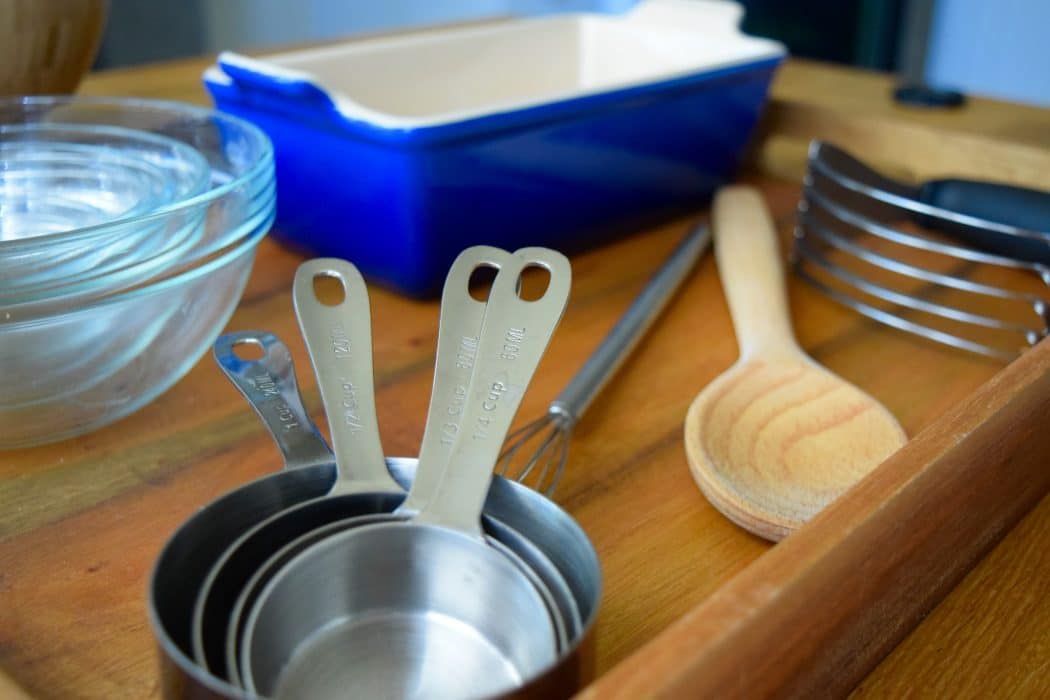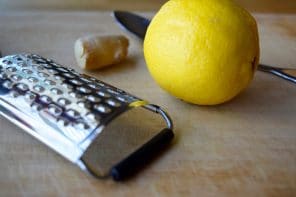This is the second installment of my “Ultimate Cooking Guide” series. The first can be read here: The Ultimate Cooking Guide: Terms
Kitchen tools make a big difference in the kitchen. Not only do they enable us to cook beyond barbecue, they can make things a lot easier and a lot more interesting. It doesn’t require a ton of tools to make a wide range of recipes, but of course it all depends on what you make often. As someone that doesn’t eat meat, a meat thermometer isn’t necessary. But many of these tools are quite useful to have on hand.
I didn’t include every kitchen tool. I left out ones that were obvious (like a can opener) as well as some that were not commonly used.
Baking and Pastry Tools:
- Baking sheet: metal sheets used to bake things like cookies, bread, and pastries or to use to make fries, chips, or crisps.
- Bundt pan: a round cake pan that is hollow in the center.
- Cake pan: shaped pans made for making cakes.
- Casserole dish/pan: an oven safe container of varying sizes for baking food.
- Cooling rack: a metal rack that helps circulate air around food to help in the cooling process.
- Gratin: a shallow oven safe pan that is oval in shape.
- Loaf pan: also called a bread pan, is a narrow rectangle pan for cooking loaves and bread.
- Measuring cups and spoons: cups and spoons made to the correct size to measure out needed amounts of ingredients.
- Mixing bowl: multipurpose bowls in a variety of sizes to help mix ingredients separately before mixing together or to use for anything in the cooking process.
- Muffin pan: a pan with cups for making cupcakes and muffins.
- Pastry cutter: several sharp, rounded pieces attached to a handle to cut butter or fat into flour.
- Pie pan: a shallow pan with raised, sloped sides for making pies.
- Pizza stone: a flat, food safe stone for pizzas and breads to create a crisp crust that doesn’t stick.
- Ramekin: a small dish/bowl for baking and then serving individual portions.
- Rolling pin: A long cylinder, sometimes with handles, to roll out ingredients or items like dough.
- Roasting pan: a metal pan with raised sides for roasting food in large quantities.
- Tart pan: a shallow pan with raised sides for making tarts. Sometimes has a removable bottom.
Stovetop Tools:
- Dutch oven: a cast iron pot with a lid that can be used on the stove or in the oven.
- Grill pan: a pan for the stove that has raised grooves for giving food a grilled appearance.
- Paella pan: a wide, round pan that is shallow with sloped sides and handles. Traditionally used for paella.
- Sauce pan: a pan with high straight sides that are squared off.
- Saucier: a saucepan with high sides that are rounded off.
- Saute pan: a wide pan with straight or curved sides that are higher than a frying pan’s but lower than a sauce pan.
- Skillet: a wide pan that has sides that flare out.
- Stock pot: a large pot that holds a lot of food. For boiling things like pasta or making soups and stews.
- Tagine: a wide, shallow pan with a tall lid that has a small opening at the top.
- Wok: a large bowl shaped pan with high, round sides that endure high heat.
Cutting Tools:
- Chef’s knife: an everyday, multipurpose knife around 8 to 9 inches.
- Cleaver: a large flat knife for chopping ingredients, great for transferring them too.
- Cutting board: the item that ingredients are chopped and cut onto. Comes in a large variety, typically plastic or wood.
- Food mill: a device with a handheld crank to puree or mash foods.
- Garlic press: a tool that, when squeezed, presses raw garlic cloves into minced garlic.
- Grater: several varieties are available in different sizes and different size grates. Used to grate ingredients into smaller pieces (box grater) or zest citrus (microplane grater).
- Honing steel: a round, rough piece of metal attached to handle to sharpen knives.
- Kitchen shears: food safe scissors reserved for use in the kitchen.
- Mandoline: a utensil with a flat frame with an attached blade for slicing.
- Paring knife: a smaller knife, around 3 to 4 inches, that is used to peel and core fruits and vegetables.
- Santoku knife: a knife that’s between a chef’s knife and a cleaver in shape. Another multipurpose knife for dicing, chopping, and mincing.
- Serrated bread knife: a long knife, at least 8 inches, that is used to cut bread.
- Tomato knife: a serrated knife, typically with prongs, for cutting tomatoes and citrus without squishing them or tearing their skins.
- Utility knife: smaller than a chef’s knife, but larger than a paring knife for fast and easy purposes like cutting a sandwich.
- Vegetable peeler: vegetable peelers are either y-shaped or swivel, used to peel the skin off of fruits and vegetables.
Spoons, Whisks, and More
- Ladle: a deep spoon with a long handle for serving soup.
- Slotted spoon: a spoon with slits or holes to allow liquid to drain from a food.
- Spatula: essentially a handle with a flat end for flipping food like pancakes or for stirring.
- Tongs: Two flat pieces are joined together to flip, toss, serve, or pick up food.
- Whisk: wires are attached to a handle in order to beat or stir ingredients.
Appliances:
- Blender: a mixing machine that is a pitcher with blades for blending, pureeing, liquifying, or chopping.
- Food processor: a machine that is a bowl with spinning blades for blending, pureeing, liquifying, chopping, grating, etc.
- Immersion blender: a handheld stick with protected blades for blending things like soup right in the pot.
- Pressure cooker: a pot that cooks food with a small amount of liquid and and pressure to create a rise in temperature.
Miscellaneous:
- Citrus juicer: a tool to separate the juice from the pulp and seeds of citrus.
- Colander: a bowl with holes of varying sizes used to drain liquid from food.
- Mortar and pestle: a bowl with a handheld tool for grinding, mashing, and crushing ingredients.
- Pepper mill: a tool that grinds peppercorns
- Potato masher: a flat tool that mashes ingredients.
- Waffle maker: an electric or stovetop pan that cooks batter in the shape of a waffle.





